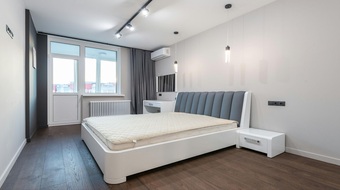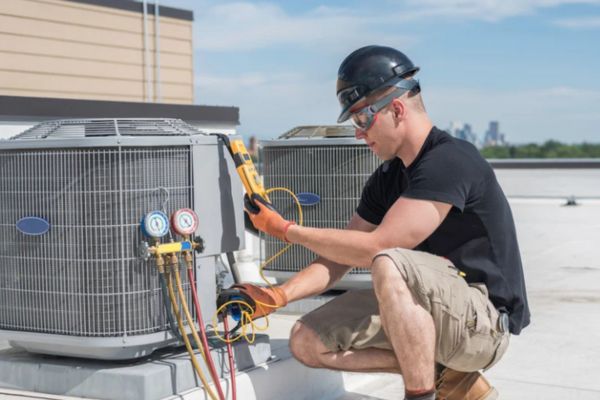It’s frustrating when your air conditioner is on but not cooling your home. Not only does this make things uncomfortable, but it can also raise your energy bills. That’s why it’s important to figure out what’s causing the problem as soon as possible. Let’s go over some common reasons this happens, tips for fixing it, and when you should call a professional for help.

Top Reasons for AC Running But Not Cooling
There could be a few reasons if your AC is running but not cooling the air. Knowing these issues can help you determine what’s going wrong.
Clogged Air Filter
A clogged air filter is a common reason your AC isn’t cooling well. When the filter gets blocked, air can’t flow properly, so the AC has a hard time pushing cool air around your home. Cleaning or replacing the filter usually fixes the problem.
Refrigerant Leak
If your AC isn’t cooling well, it could be because it’s low on refrigerant. Refrigerant helps cool the air, and if there’s a leak, a professional will need to fix it and refill the refrigerant.
Thermostat Misconfigurations
Sometimes, the problem could be an incorrect thermostat. If your thermostat isn’t set to “cool” or the temperature isn’t right, it can cause the AC to run ineffectively. Always double-check the settings before looking into more complex issues.
Outdoor Unit Blockage
The outdoor unit helps cool your home. If things like leaves, dirt, or plants block it, it can’t work as well. Cleaning around the unit regularly can help it cool better.
Dirty Evaporator or Condenser Coils
Over time, dirt and grime can build up on the coils of your AC, making it harder for them to move heat properly. This can stop your AC from cooling well, so cleaning the coils helps it work better.
Electrical Failures
Your AC needs electricity to work properly. If there’s a problem with the wiring or a part like the capacitor, it can stop cooling. These issues usually need a professional to fix them.
AC Unit Too Small for the Space
Sometimes, the issue isn’t with the AC itself but relatively its size. If your air conditioner is too small for the cooling space, it will struggle to meet the demand, especially on hot days. Ensuring the unit is the right size for your home is crucial for adequate cooling.
DIY Troubleshooting Tips
Before calling in a professional, you can check a few things yourself. These simple steps can resolve the problem without needing expensive repairs.
Check Thermostat Settings
Start by ensuring that the thermostat is set to “cool” and the temperature is lower than the current room temperature. It sounds simple, but an accurately configured thermostat can easily fix poor cooling.
Replace or Clean the Air Filter
A dirty air filter restricts airflow and is one of the most common reasons AC units stop cooling effectively. Check your filter; if it’s dirty, replace or clean it to restore airflow.
Inspect and Clean the Outdoor Unit
Debris, like leaves, dirt, and grass, can accumulate around the outdoor condenser unit, blocking airflow. Clear the area around the unit, and if necessary, use a gentle hose to clean the condenser coils.
Examine Airflow from Vents
Make sure nothing, like furniture or curtains, is blocking the vents in your home. If the vents are blocked, your air conditioner won’t work as well. Moving things around can help fix the problem.
Check Circuit Breaker and Fuses
Your AC might stop working if a circuit breaker trips or a fuse blows. Go to your electrical panel and try resetting the breaker. If it keeps tripping, you should call an expert to fix it.
When to Call an HVAC Professional
While DIY troubleshooting can sometimes resolve the problem, there are instances where calling a professional is necessary. These complex issues typically require the expertise of a licensed technician.
Refrigerant Issues
If your AC has a refrigerant leak or low levels, you’ll need a professional to refill and repair the system. Handling refrigerants requires special certification, and trying to fix this yourself could be dangerous.
Electrical Problems
Electrical problems, like broken wiring, capacitors, or motors, are best fixed by professionals. These issues can be dangerous, so it’s safer to let trained HVAC technicians handle them to avoid injury or making things worse.
Internal Component Failures
If the compressor, fan motor, or other parts of your AC are broken, you need a pro to fix or replace them. Trying to do it yourself might cancel your warranty or make the problem worse.
Preventative Maintenance to Avoid Future Problems
Regular preventative maintenance is the best way to avoid future AC cooling problems. Keeping your system in good shape will help ensure it runs well throughout the year.
Regular Filter Replacement
Changing your air filter every 1-3 months keeps airflow steady and prevents the AC from overworking. Regular filter replacement is one of the easiest ways to avoid cooling problems.
Seasonal HVAC Inspections
Schedule professional inspections at least once or twice a year, ideally before the cooling and heating seasons. A professional technician can identify potential issues early and perform necessary maintenance to keep your system running smoothly.
Keep Coils and Outdoor Unit Clean
Cleaning the condenser and evaporator coils at least once a year will prevent dirt buildup from impacting efficiency. You should clean the debris around the outdoor unit regularly to maintain proper airflow.
Monitor Refrigerant Levels
Have your refrigerant levels checked during annual inspections to ensure no leaks are present. Refrigerant levels that are too low can lead to poor cooling and may damage the system over time.
Conclusion
If your AC is running but not cooling, acting quickly is key to avoiding further discomfort and higher energy bills. While some issues can be resolved with simple troubleshooting, others may require professional help. Taking care of your AC regularly helps it work better and keeps your home cool all summer.


